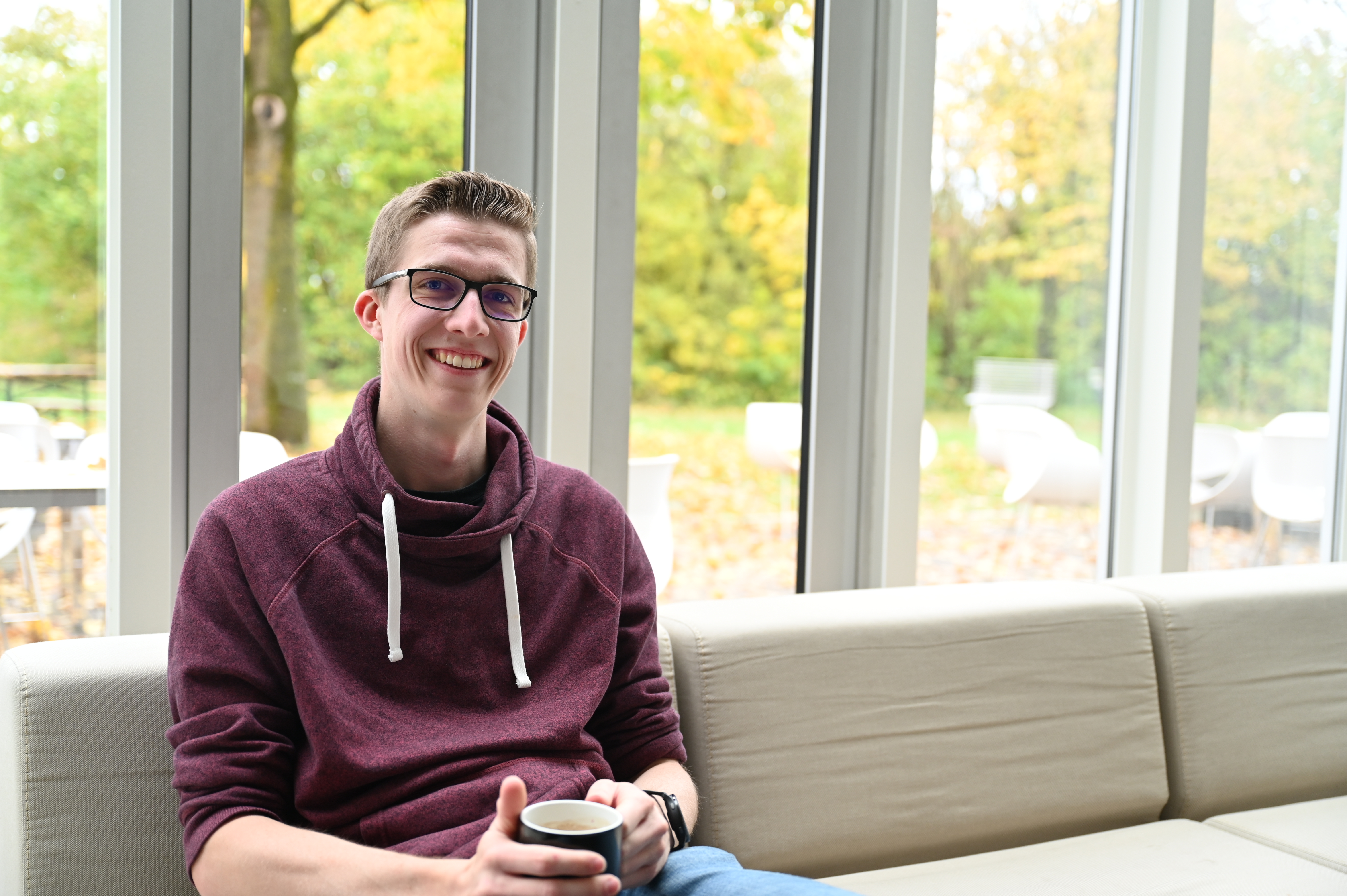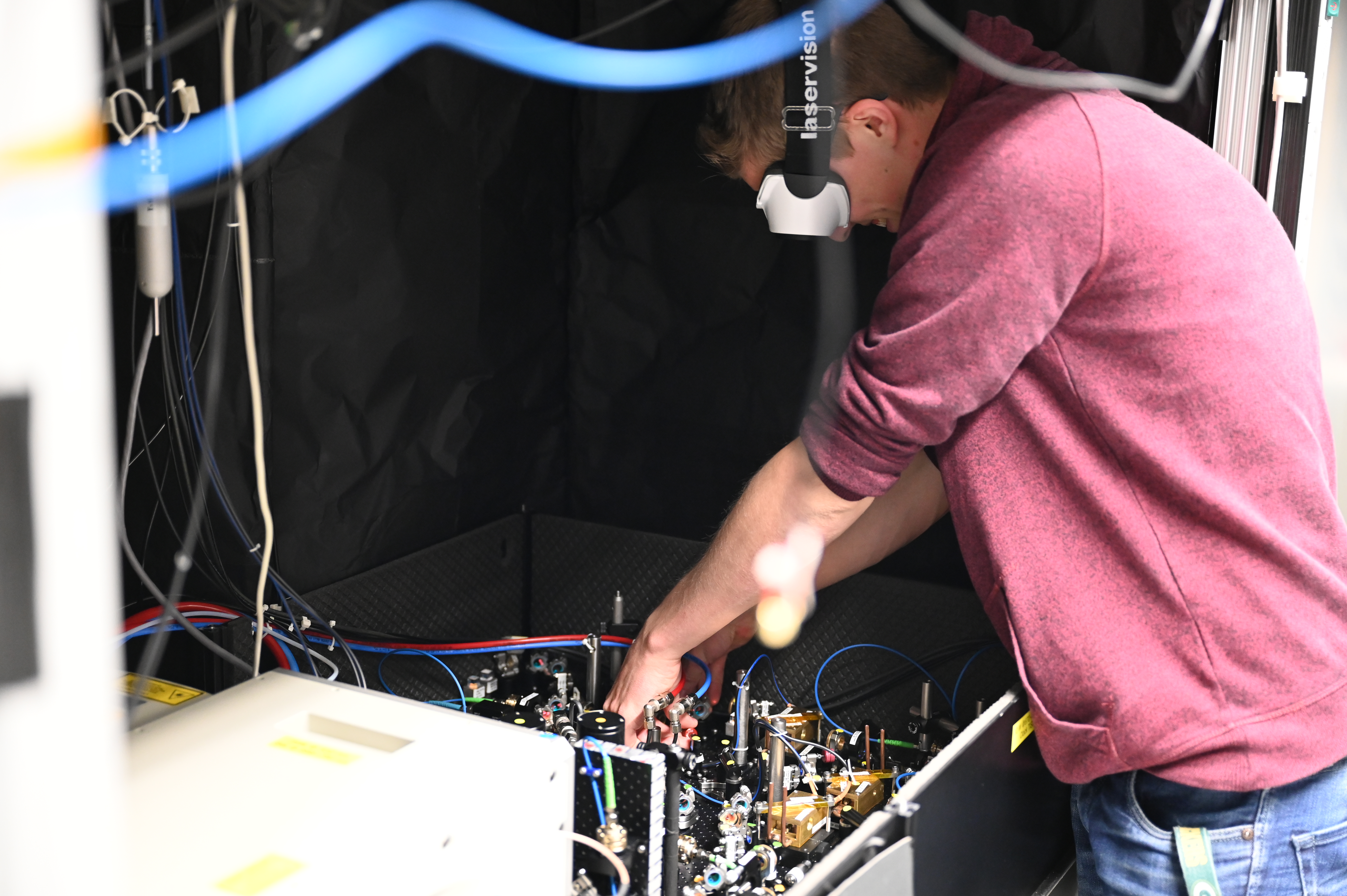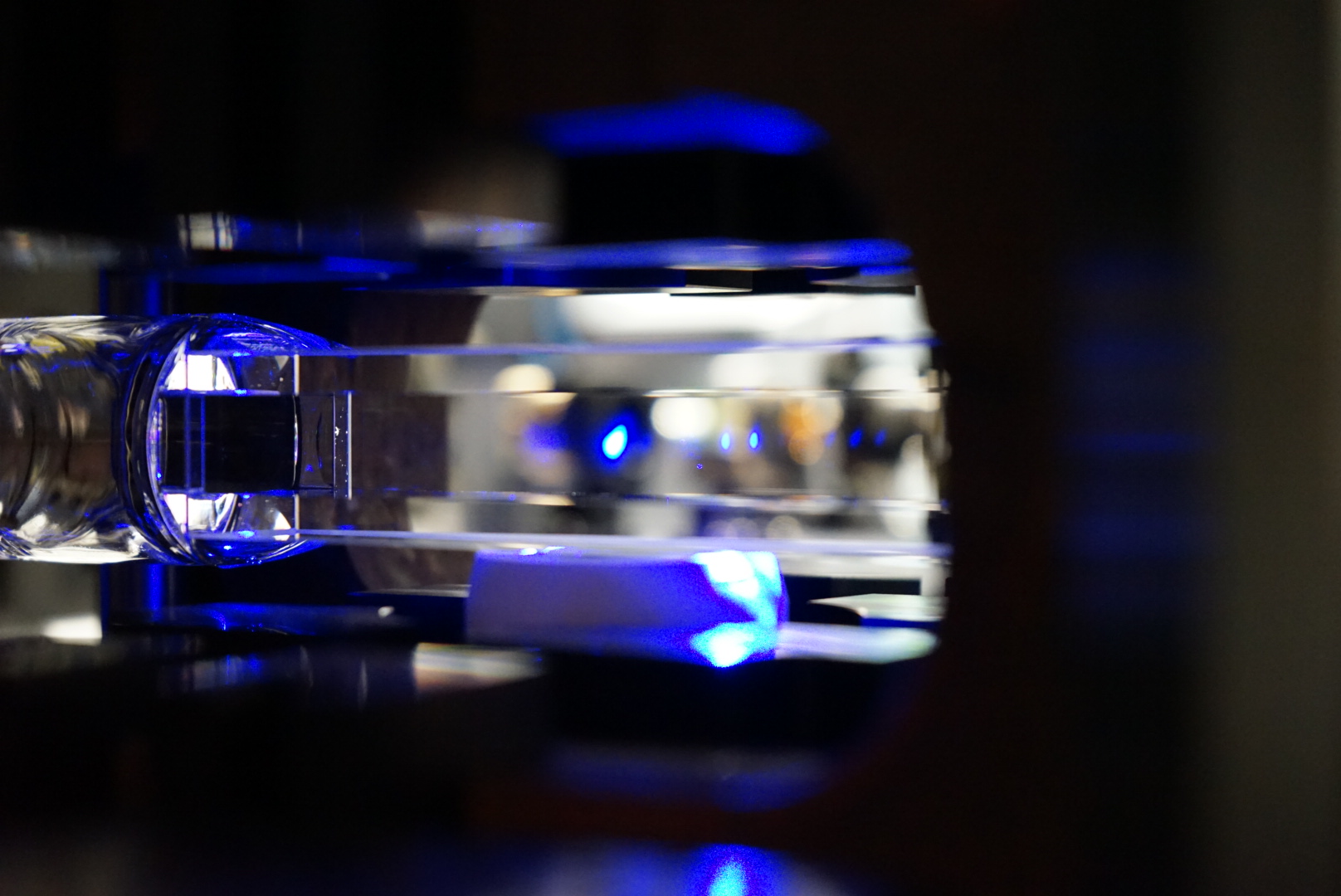"We shoot however many lasers at atoms until they do what we want"
Building digital quantum computers from atoms
Kevin Mours is so enthusiastic about physics that he began his studies while still at school. Today, as a Ph.D. student at the Max Planck Institute of Quantum Optics, he builds experiments that capture individual atoms.
By Veronika Früh
The coffee machine in the kitchen of the "MQV Quantum Computing" research group at the Max Planck Institute of Quantum Optics (MPQ) is connected to an unusual number of cables. Kevin Mours, a doctoral student in the group, points to a small circuit board and a computer screen: "I helped a colleague write a program that replaces our tally sheet for coffee and digitizes our internal billing". He smirks. He has a hard time denying the experimental physicist in him.
"I always keep asking why, why, why" – that's how Kevin Mours describes his motivation. And for him, physics can best answer his questions about why the world behaves the way it does. The 24-year-old has been fascinated by the natural sciences since elementary school. Physics soon emerged as his particular interest. "I've been taking part in competitions since seventh grade. So it was clear that my future would be about physics, in whatever way," he explains. It was obvious that the normal physics classes in high school quickly didn't go far enough for him, even in the advanced physics course.
So he decided to start studying physics in his last year of high school. The University Kaiserslautern-Landau (RPTU) offers a special "Early Entry into Physics Studies" program for this purpose. As Kevin had already ticked off the first courses with the program, he was able to start his regular technophysics course – a combination of mechanical engineering and physics with a stronger focus on application and an engineering perspective – in a much more relaxed manner. "I was always a bit more interested in physics," Kevin admits, "but at the same time I found it very exciting to think about how to put what I had learned into practice."
Controlling atoms with lasers
However, his path then led the doctoral student away from applied research and back to basic research at the MPQ. To describe his own work as simply as possible, Kevin likes to fall back on his standard phrase, as he himself says: "We shoot however many lasers at atoms until they do what we want them to do". That would actually sum up his experiment perfectly.
For those who want to know more, Kevin explains the aim of building a digital quantum computer utilizing individual atoms. Two previously selected states of the atom are encoded as 0 and 1. "Just like in a classical computer," explains the doctoral student, "except that switching from a 0 to a 1 works differently." This is where the lasers come into play, allowing the researchers to control and superimpose the states of the atoms in a precise manner.

Kevin Mours, 24
Position
Ph.D. student
Institute
MPQ – Quantum Many-Body Systems Division
TAQC
Degree
Technophysics
Kevins' research is focussed on the construction of a digital quantum computer with neutral atoms. Using powerful lasers, he traps single atoms in optical tweezers to be able to encode and control them as individual qubits.

Currently, the experiment Kevin is working on is still under construction. When the doctoral student started at MPQ around a year ago, the planning phase was just over and most of the necessary parts had been ordered. While his colleagues were installing the vacuum system, Kevin began assembling the first optical elements. "Somehow we have to get the light from A to B and set the right frequencies at the same time," explains the doctoral student. Aligning the many individual lenses and mirrors and setting up the electronics behind them took up a large part of his time.
The group can now control individual atoms and play with the intricacies of the frequencies and magnetic fields. For Kevin, this means: "I go into the lab, press a few buttons, run the measurement and evaluate it on the computer". Depending on the measurement result, he then has to tweak the experiment again and readjust the individual elements or add new components – until everything is set up perfectly so that they can execute one-qubit gates. In the next step, Kevin and his colleagues want to realize two-qubit gates, which will allow for a wider range of computer operations.

Happiness is a little blue cloud
Kevin describes one of the proudest moments in his research career to date as the first time he and his colleagues were able to see the atomic signal in their experiment. "It may sound a bit ridiculous to outsiders at first, but seeing that blue line in the glass cell was just amazing. It is the moment we know we have atoms exactly where we want them to be. That's something I was really happy about". Even though the observable pixels on the computer screen are now more interesting to him, he is still happy every time he sees the blue "cloud" – atoms that are caught in the magneto-optical trap (MOT) and emit blue light when they fall back to their ground state. The colored pixels that he can see on the screen are individual atoms trapped in tweezers that fluoresce during this transition.
It took around six months to get to this point – but for Kevin, the motivation to help build such a big experiment always won out over the frustration of fine-tuning. He knew every little screw and the function of every controller right from the start. "This part of the experiment is a little bit like my baby," he says, looking at the optical table with its numerous lenses and colorful cables. Even though the setup itself is Kevin's work, it is important for him to emphasize that it is of course the work of the entire team behind it, which he is quick to praise: "I work in a very motivated team that is really excited about this experiment. That always inspires me, even though there was no need for much external motivation so far."
Being involved in setting up the experiment from the very beginning was one of the main factors for Kevin to come to MPQ. He knew he wanted to work with Rydberg atoms and optical tweezers after his master's thesis and broaden his horizons again with his background in ultracold quantum gases. The MQV project was a perfect fit. During his master's thesis at UC Berkeley, he met Immanuel Bloch, director at MPQ, and Johannes Zeiher, head of several research groups at MPQ, at a conference. The fact that he immediately had a good feeling was ultimately the catalyst for his decision to apply for the position in their group later on. "I started here within two weeks of coming back from Berkeley," Kevin says with a laugh. "I only had to go back to Kaiserslautern to drop my Master's thesis in the mail."
Between the lab and the mountains
The one thing that the doctoral student now appreciates about Bavaria as much as he did about the Bay Area around San Francisco is the opportunity to spend his free time hiking. When it comes to store opening hours, however, things are different. After his time in the U.S., where supermarkets were open around the clock, he sometimes finds it difficult to go shopping before eight o'clock in his everyday working life here. Especially when he's working on a new problem and forgets the time – "then you realize there's probably nothing left to eat today," he says and laughs.
But even if it takes longer, as long as the time passes so quickly that he only notices it when he looks at his watch, Kevin has no problem with it. And a seemingly unnoticed night shift has another advantage: the quieter it is in the lab, the better his measurements with the very sensitive setup go. He occasionally uses the weekend to do this, when his motivation is just too strong to wait until Monday. However, this doesn't happen too often, the doctoral student assures. And if it does get too much, he heads for the nearby mountains to balance things out.
Published 26 January 2024; Interview 31 October 2023